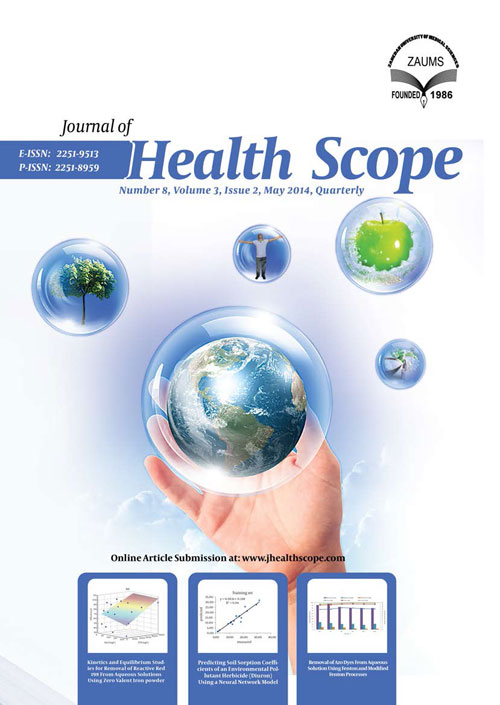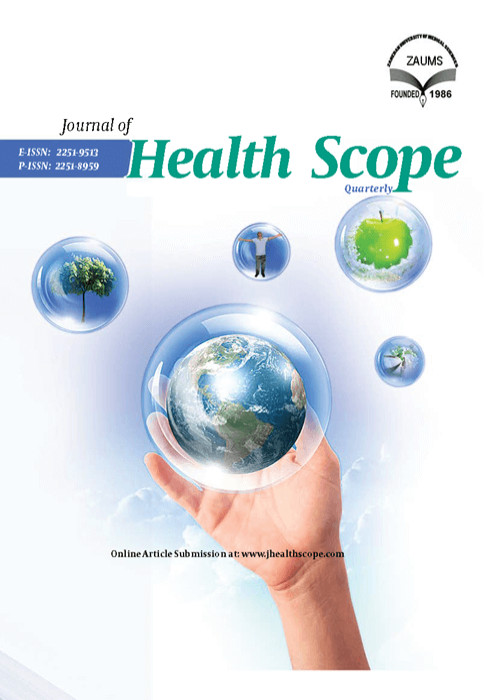فهرست مطالب

Journal of Health Scope
Volume:4 Issue: 3, Aug 2015
- تاریخ انتشار: 1394/06/09
- تعداد عناوین: 7
-
-
Page 2BackgroundDespite efforts made by the medical community and public health officials for combating 76 obesity, the prevalence of overweight and obesity has increased over the past 20 years. 77 Obesity was associated with some cardiovascular risk factors and increased the incidence of 78 cardiovascular disease. Diagnosis of Coronary Artery Disease (CAD) in patients with obesity 79 will affect secondary prevention of the disease and management programs; for this reason it is 80 necessary to use a suitable method for determining obesity.ObjectivesThe current study aimed to investigate the relationship between some anthropometric indices and Coronary Artery Disease (CAD) risk factors and also to determine predictive factors of CAD among the indices..Patients andMethodsThis cross-sectional study was performed on 300 men and nonpregnant woman with CAD aged 18 - 60 years referred to Hazrate Rasool Hospital in Tehran, Iran. Anthropometric indices, including waist circumference, waist-to-height ratio, Neck Circumference (NC), body mass index and Abdominal Volume Index (AVI) and hematological factors were measured using the standard methods. According to angiography reports, the participants were divided into patients with or without CAD. To evaluate the possible correlations between anthropometric indices and CAD risk factors, Pearson correlation coefficients were used. The Receiver operating characteristic (ROC) curve was used to determine the sensitivity and specificity and the best cut-off point of anthropometric indices..ResultsThe mean age of the CAD-positive group was 53.43 ± 4.96 years and the mean age of the CAD-negative group was 49.9 ± 6.83 years (P > 0.05). All of the anthropometric indices and cardiovascular risk factors were higher in the CAD-positive group, while there was a significance correlation between HDL-c (High-density lipoprotein) and these risk factors (P < 0.05). The area under the curve of AVI had the highest value (0.722) compared to other anthropometric indices. The results of multiple-regression analysis showed that NC was a better predictor of the risk of CAD compared to other anthropometric indices (P = 0.46, OR = 1.207 and CI = 1.004 - 1.451)..ConclusionsAccording to the results of the study, abdominal obesity is as a risk factor for atherosclerosis. Therefore, the use of a simple, low cost and high precision method for determining visceral obesity and preventing the CAD is warranted..Keywords: Coronary Artery Disease, Abdominal Volume Index, Neck Circumference
-
Page 3BackgroundChronic pain has been estimated to affect between 2% - 40% of the adult population and its prevalence is increasing..ObjectivesThis study aimed to provide epidemiological data of chronic pain and associated factors in Tehran, capital of Iran..Patients andMethodWe analyzed the data of 23457 people, from the Urban HEART-2 (health equity assessment and response tool) study in Tehran, collected in October 2011, and determined the association between any type of chronic pain and other variables using multiple logistic regressions..ResultsThe prevalence of chronic pain among adults in Tehran City was 24%. Chronic low back pain and chronic knee pain were the most common complaints (12.4% and 11.2%, respectively). A significant difference was found in the prevalence of chronic pain between districts of Tehran (P < 0.001). Associated factors were different for different types of chronic pain, and anxiety and increasing age were identified as common risk factors associated with all types of chronic pain (P < 0.001)..ConclusionsThe results of this study show a considerable prevalence of chronic pain among adults in Tehran. Therefore, it is necessary to pay more attention to different types of chronic pain by planners and policy makers..Keywords: Chronic Pain, Risk Factors, Prevalence, Epidemiology
-
Page 4BackgroundAutism spectrum traits may present in a normal population without interfering with daily functionings. It seems that emotional intelligence (EI) is one of the factors effective in autism spectrum disorders (ASDs)..ObjectivesThis study aimed at predicting ASDs based on EI and its dimensions (i.e. appraisal, utilization, and regulation of emotions) among university students..Patients andMethodsIn this descriptive correlational study, 100 students of the Babol Branch, University of Payam Noor, were selected using the voluntary sampling method in the academic year of 2013 - 2014. The participants were asked to fill in a questionnaire containing demographic characteristics, the Autism Spectrum Quotient, and the Modified Schutte Emotional Intelligence Scale. The data were analyzed using SPSS software (version 21), Pearson correlation coefficient, and regression analysis..ResultsThe results showed a significant negative relationship between total EI and all its components (i.e. appraisal, utilization, and regulation of emotions) with ASDs in the students (P < 0.01). The results of the regression analysis indicated that global EI and 2 of its components (i.e. utilization and regulation of emotions) were able to predict the variance in ASDs in the students (P < 0.01)..ConclusionsOur findings highlighted the importance of EI and its aspects in ASDs in the university students recruited in the present study. Therefore, improvement in EI and its dimensions can decrease autism symptoms and signs in individuals with ASDs. Overall, the result of this study emphasizes the key role of EI as a plausible health predictor..Keywords: Child development disorder, Pervasive, Emotional intelligence, Emotion regulation, Health
-
Page 5BackgroundSolvents such as benzene and toluene are commonly used in tire manufacturing, and significant occupational exposure to these chemicals adversely affects the health of workers. In biological monitoring, a complementary method for personal monitoring, the internal absorbed dose is measured and individual, environmental, and exposure differences are taken into consideration..ObjectivesThe present study evaluated external doses by personal monitoring and investigated a more practical approach to biological monitoring by measuring the internal doses of benzene and toluene in workers involved in tire manufacturing..Materials And MethodsPersonal monitoring of 100 workers in tire factories A and B (n = 50 samples from each factory, n = 100 total personal samples) was performed using the national institute for occupational safety and health 1501 method. Biological monitoring of the workers was performed by collecting exhaled air in Tedlar® bags (n = 100). Personal and biological samples were analyzed by a gas chromatograph equipped with a flame ionization detector. Data were analyzed by independent t-test and correlation coefficients..ResultsThere were no significant differences between factories with respect to worker age or work history. Personal exposure to benzene exceeded the current threshold limit value in 68% of workers. Occupational exposure to benzene and toluene as external (i.e. in the breathing area) and internal doses (i.e. in the exhaled air) were significantly higher in factory B than factory A. In addition, the external and internal doses of both compounds were significantly correlated..ConclusionsThe workplace conditions of tire factories must be improved. The biological exposure index can be calculated by determining the unchanged benzene and toluene concentrations in exhaled air; this can be used as a more reliable method for personal monitoring..Keywords: Benzene, Toluene, Biological Monitoring, Exhaled BreathExhaled Air, Personal Monitoring, Tire Manufacturing
-
Page 6BackgroundArsenic is one of the hazardous elements, and drinking arsenic-rich water could cause various diseases such as cancer. The standard by the world health organization (WHO) and Iran for arsenic in drinking water is 10 µg L-1 and 50 µg L-1, respectively..ObjectivesThis study was conducted to survey the arsenic concentration in the rural water resources of Rivash, Kashmar..Materials And MethodsIn this cross-sectional study, 60 samples were gathered from 10 sampling stations (all water supplies in Rivash, Kashmar) from April to June 2013. All the water supplies were groundwater (i.e. wells and springs). The sampling and preservation of the samples were performed according to the standard methods, and assessment was conducted using the Vapor Generation Accessory (VGA) method. Some factors such as pH, total dissolved solids (TDS), and electrical conductivity (EC) were tested to survey their relationship with the arsenic concentration. The data were analyzed using SPSS and the statistical tests of one-sample t-test and Mann-Whitney at a significance level of 0.05. The arsenic level was thereafter compared with the national and international standards..ResultsThe average arsenic levels in stations A, B, C, D, E, F, G, H, I, and J were 1.53 ± 1.03, 1.30 ± 1.07, 10.55 ± 3.83, 11.21 ± 5.01, 10.57 ± 3.68, 2.34 ± 0.73, 3.22 ± 0.58, 9.89 ± 3.57, 10.48 ± 5.07, and 2.23 ± 0.53µg L-1, respectively. The arsenic concentration levels were higher than the WHO guideline in 5 stations and lower in the others, but in none of the stations did the levels exceed the national standard. The difference between the arsenic levels and the national standard was statistically significant (P < 0.001). The difference between the arsenic levels in 50% of the stations and the WHO standard was significant (P < 0.001). There were no significant relationships between the arsenic level and TDS, EC, temperature, salinity, and residual chlorine, with the exception of pH..ConclusionsGiven the high levels of arsenic in the Rivash water sources, it is essential that a plan be devised to replace the current supply with safe drinking water. Moreover, these water resources should be monitored regularly regarding the risk of contamination with arsenic..Keywords: Arsenic, Water, VGA
-
Page 7BackgroundNoise from traffic is a major source of environmental pollution in different countries..ObjectivesThis study aimed to investigate the effect of noise on professional drivers’ health and hearing loss in Tehran, Iran..Materials And MethodsThis cross-sectional descriptive and analytic study was performed on 1901 professional drivers referred to one of the authorized occupational health clinics in Tehran, Iran, in 2011. Basic demographic data including height, weight and age were recorded. Moreover, body mass index (BMI), cholesterol, triglycerides and audiometry tests were performed..ResultsThe results of BMI showed that the 44.7% of professional drivers were overweight, 16.7 % moderately obese and 4.2% were severely obese. Cholesterol of drivers, 27.3% was border line high risk and 13.3% high-risk. Triglycerides of drivers, 19.5% were border line high risk and 25.8% high-risk. The mean age of the drivers, cholesterol, triglycerides and BMI were 41.56 ± 10.57, 193.12 ± 42.63, 176.21 ± 118.21 and 26.89 ± 4.29, respectively. The rates of hearing loss in high audiometric frequencies were more than at low audiometric frequencies. Hearing loss in older drivers was more and this was due to the long exposure to noise pollution..ConclusionsDue to the long exposure to the loud noise during the day, hearing loss in drivers is significant. The left ear displays greater loss than the right ear. Therefore, strategies to prevent hearing loss in drivers could include education, lifestyle changes and compliance issues related to hearing health, use of personal protective equipment, conducting periodic examinations and early treatment.Keywords: Noise, Noise, Induced, Hearing Loss


